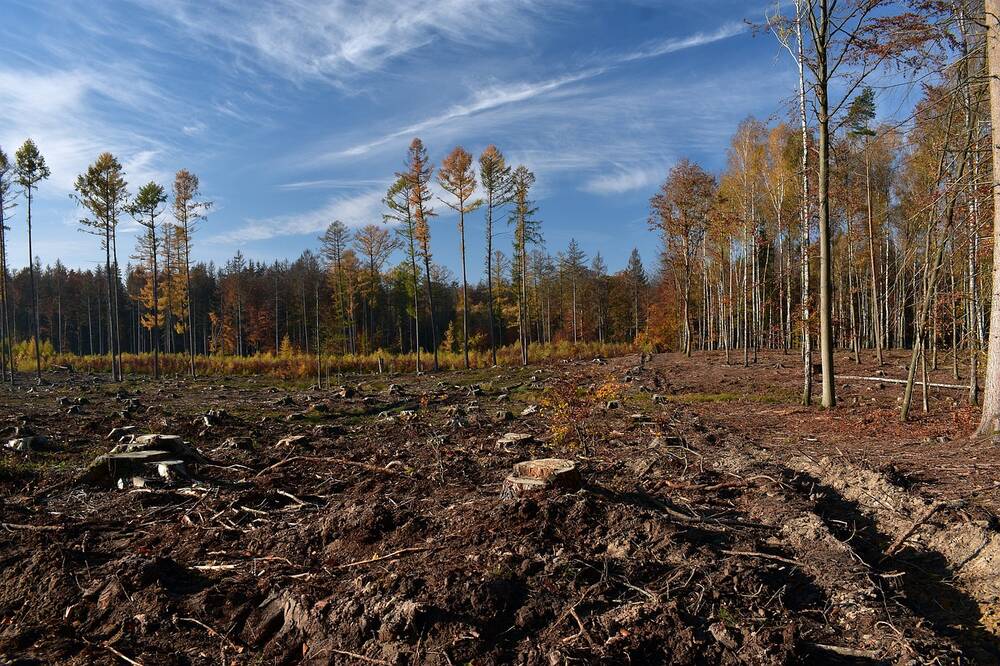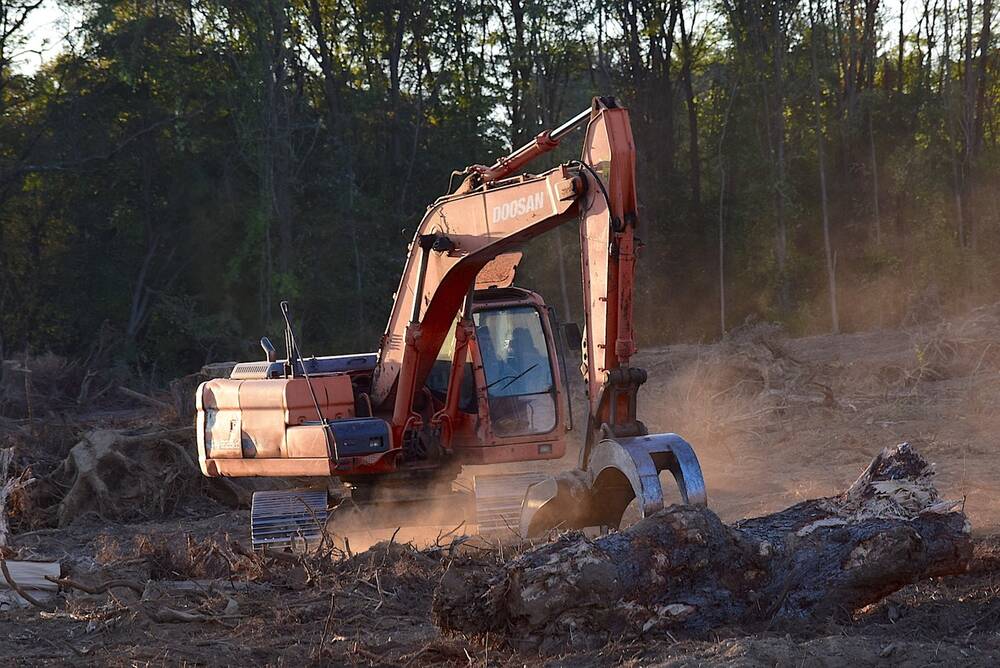Deforestation affects everything. It is driven by many things such as infrastructure development, agriculture expansion and resource extraction, largely propelled by urbanisation.
The wiping out of rich, lush forests contributes heavily towards our global biodiversity crisis, and this blog explains various causes as well as conservation and mitigation strategies. It delves into the specific effects of deforestation on ecosystems, biodiversity and nature, to understand the many ways that nature is depleting due to human activities.
This article will provide key examples of deforestation for main forests, from the Central African Rainforests to the Amazon, and the main contributors to their increasing rates of deforestation.
What is Deforestation?
Deforestation is when trees and forests are cut down at a small or large scale for the purposes of agriculture, logging, urbanisation, infrastructure development, resource extraction or other needs. It’s globally recognised as extremely harmful to the environment, as well as displacing indigenous communities and robbing the livelihoods of forest-dependent people.
Forests, woods and trees are some of the strongest carbon dioxide sinks on the planet, and wiping them out causes a huge increase in CO2 levels, enhancing global warming and disruptions in weather patterns. Deforestation obstructs water cycles, leading to further unseen weather changes.
Reforestation is a mitigation strategy, but at times cannot compete. Sustainable forestry practices and conservation programs have administered widespread global efforts to combat deforestation and aid the environment.
Causes of Deforestation

Agricultural Expansion
Deforestation is widely driven by agricultural expansion, with demands for food and biofuels increasing as biodiversity levels decline and dependences on finite sources are depleting. Forests are cleared to make room for cropland for agricultural purposes.
Agriculture is one of the main causes of forest conversion in the Amazon. This causes erosion in soil and river siltation, harmful to biodiversity and nature. The chemicals used for agriculture such as those in pesticides and fertilisers pollute water and degrade aquatic habitats.
Logging Operations
Logging operations contribute heavily towards the world’s deforestation crisis, with trees used in timber commercially, such as oak for furniture, coniferous trees for paper or various trees for lumber.
Trees are commonly cut down to be burnt for fuel and utilised in heating, cooking and charcoal production. This happens all around the world, especially in more rural areas in Africa and South Asia, providing energy for households, while deforesting crucial habitats for wildlife and carbon sinks fighting global warming.
Logging practices can happen illegally, such as rosewood extractions in Madagascar and illegal teak logging in Myanmar.
Infrastructure Development
Forests can be partially cleared to make way for infrastructure development, such as roads or bridges that cross through the forest, creating habitat barriers for local wildlife.
Forests can be wiped out and entirely cleared to make space for large-scale urban development and expansion, accommodating the growth of cities, which further requires resources that could come from the forest such as timber.
This leads to tourism development, especially in areas with beautiful forests, resulting in increased infrastructure from hotels or resorts which heightens deforestation.
Mining Activities
The majority of deforestation for mining is in pursuit of gold and coal, and these are heavy contributors globally. Accessing large mineral deposits can require large areas of land, requiring the removal of tracts of forests, making room for processing plants, access roads, excavation pits or waste disposal areas.
This pollutes the forest, such as dumping waste on the forest floor, harming the vegetation and habitat. The mining activities can further disturb the soil, eroding and degrading the land, in turn making it harder for the forests to regrow and regenerate.
As their excavations and successes develop, so does the land area, meaning more and more of the forest is wiped out as the natural resources are extracted.
Urbanisation
Urbanisation and increasing consumer demands worldwide are one of the primary drivers of deforestation. Cities expand and forests must be wiped out to make space for infrastructure development, resource extraction and habitats are lost.
Factories and industrial zones replace forests, at times taking our most powerful carbon sinks and climate-change mitigators and replacing them with pollution-powering hotbeds for global warming, to keep up with expanding societal urban demands.
Populations increase in urban areas, leading to excess removal of forests to create housing, usually requiring more resources from forests to be used in construction. People abandon rural areas and intensify consumer demands in cities.
Impacts of Deforestation on Biodiversity

Loss of Habitat
Deforestation is the immediate removal and wiping out of habitats, including various micro-habitats and microclimates. Animal species can depend on single trees for their nesting, shelter or food resources, however deforestation goes all the way to hundreds of thousands of hectares removed in one go.
Trees maintain healthy soils, and when removed, soils become eroded, with lower qualities of remaining habitats for animals and plants.
Remaining habitats can be left fragmented, with fewer habitats in isolated patches, separated by dangerous barriers such as busy roads with traffic that some fauna will struggle to safely cross.
Deforestation disrupts essential ecosystem services that would have contributed to a healthy, thriving ecosystem beforehand, as well as essential water cycles that animals are dependent on for local water availability.
Reduction in Species Diversity
Deforestation kills habitats, and not unusually the species depending on them for their livelihoods. Numbers of species lower as displaced animals that cannot survive outside of their natural habitats die.
With populations decreasing, some even taken into extinction, species diversity is lost and ecosystems lose foundational structure. This makes them heavily susceptible to external harm like climate change.
With amended environments inhabitable to native species, the remaining animals may easily be outcompeted by invasive species, displacing or preying on the native species and rupturing the ecosystem stabilisation.
Impact on Food Chains and Food Webs
Trees are a food resource that can lie at the very bottom of the food chain as primary producers, followed by animals such as caterpillars as the primary consumer, then the bird as a secondary, the snake and so forth.
By removing the primary producer, the food chain is ruptured and populations decline, leading to ecosystem collapse.
In the same vein, a complex food web is similarly impacted, affecting a variety of primary consumers dependent on trees for food sources, conflicting various levels and routes of the web and fostering widespread ecosystem instability.
Altering of Nutrient Cycling and Soil Fertility
Forests thrive on the nuanced cycles of nature, such as leaf litter and organic matter, which feed rich nutrients into the soil, fostering healthy plant species growth and dense vegetation that goes on to support diverse wildlife. The roots of trees anchor the soil, preventing soil erosion, which is where the upper and most nutrient-rich layer of soil is deconstructed leaving less availability for healthy vegetation.
When trees are removed, forest floors are exposed and open to excesses of rainwater which harmfully leeches the soil by dissolving and carrying away the essential nutrients such as potassium, phosphorus and nitrogen deep past the roots, leaving the remaining soil less fertile for biodiversity. Healthy tree-anchored soils easily hold these nutrients, eager to support wildlife and sustain ecosystem services for the health of the habitat.
Loss of Genetic Diversity Within Species
Genetic diversity is essential to maintaining a resilient ecosystem that can adapt to change and external influences. It enhances population viability and allows them to resist diseases as those among the species with genetic variations can offer resistance.
Wiping out trees, obscuring food webs and chains, and fragmenting diverse habitats leads to harsh declines in genetic diversity.
Isolating populations limits their gene pool, which can make many species extinct. Within isolated communities animals can be confined by barriers, such as the jaguars in the Amazon, with restricted movement leading to inbreeding which causes subsequent genetic health issues.
Mitigation and Conservation Strategies
Forest loss worldwide has resulted in immense biodiversity loss now deeming us in a global crisis. Even with protected areas, the impact of deforestation has been dire, and various methods for change have been implemented.
Sustainable Forestry Practices
There are many types of sustainable forestry practices which help combat deforestation or mitigate its effects. Selective logging, for instance, is when only certain trees are cut down, aiming to leave majorities of forests intact.
These can strategically align with the habitats, such as preserving animals who inhabit a specific tree, or cutting trees while preserving the biodiverse canopy and soil or the Amazon.
Reduced impact logging (RIL) offers techniques to minimise the environmental harm to the forest and the damage to remaining trees and wildlife.
Reforestation and Afforestation
Reforestation directly combats deforestation by planting trees in areas that have been deforested, giving the forest a chance to take over again. This can be government-led or community driven, and allows for the long-term production of resources while enhancing biodiversity.
Afforestation, on the other hand, is the planting of trees in non-forested areas, creating new ecosystems that can convert degraded land, such as brownfield sites, into productive biodiversity hotspots.
Both techniques require regular monitoring and maintenance to ensure that the development is successful over time, however this lessens when trees become more established in the intermediate ages.
Establishment of Protected Areas
Deforestation wipes out habitats, and a large conservation effort to safeguard wildlife is the designation of specific habitats as protected areas. This means the forest or habitat cannot be wiped out for any reason.
Laws in the area restrict logging, mining, hunting or land development, and further regulations laid down by international bodies or governments ensure the areas are being protected through management plans.
These long-term conservation efforts help preserve native species, enhance ecosystem resilience and restore lost biodiversity.
Creation of Wildlife Corridors
Deforestation can lead to the fragmentation of forests, such as with roads or railways. These barriers stop wildlife from travelling between habitats or offering them a risky passage through traffic or other dangers.
Wildlife corridors are a method of conservation that allows wildlife to travel throughout entire ecosystems, promoting biodiversity, genetic diversity and species diversity and allowing for thriving nature. Isolated habitats lead to unstable ecosystems, weak and susceptible to external harm, such as climate change or disease.
International Agreements and National Policies
CBD (Convention on Biological Diversity) is an example of an international agreement which aims to make up for biodiversity lost globally to threats such as deforestation. The Kunming-Montreal Global Biodiversity Framework aims to protect 30% of the earth’s land and water by 2030, plus restore 30% of ecosystems that have degraded.
More specifically, there are national policies like Indonesia’s Forest Moratorium Policy or Brazil’s Action Plan for Prevention and Control of Deforestation in the Amazon (PPCDAm), which fight against logging, instead enforcing sustainable forest management and restoration.
These policies and agreements are essential for protecting life on earth, such as those from the World Wildlife Fund, actively combating deforestation and advocating for nature-first policies.
Real World Examples of Deforestation

The Amazon Rainforest
The Amazon Rainforest is feared to be getting closer to its ‘tipping point’ of deforestation, marking an irreversible amount of biodiversity loss to be a self-sustaining ecosystem.
Annual losses can transcend 10,000 square kilometres, primarily driven by logging, infrastructure development, agriculture – soybeans – and cattle ranching.
Indigenous communities that reside within the forest have been displaced or affected, such as the Ashaninka, Kayapo and Yanomami communities.
There are policies aiming to conserve the hub of biodiversity, such as Brazil’s Amazon Region Protected Areas (ARPA) program which protects and conserves large tracts throughout the forest.
Southeast Asian Forests
The Southeast Asian Forests have some of the highest rates of deforestation. They are prime areas for palm oil, with Indonesia and Malaysia as the largest producers in the world. Legal and illegal logging practices are frequent within the forests as they offer masses of sought-after tropical hardwood and timber.
The forests can be fragmented and broken up by the construction of roads, highways and further urban expansions, causing deforestation on a mass scale.
Mining for coal, gold and other lucrative resources calls for the wipe-out of huge areas of forest and creates damaging harm to the biodiversity that remains or nears the area.
Central African Rainforests
Similarly, the agricultural opportunities provided by the luscious forest contribute heavily to its downfall, with cocoa and rubber farms and plantations expanding into large-scale agricultural projects.
Logging is also common here, with a successful timber industry, as well as the production of charcoal primarily used as a fuel for cooking.
The diverse wildlife of gorillas, elephants, birds and rich wildlife may be at risk from deforestation, with various species pushed into extinction.
More Information
https://education.nationalgeographic.org/resource/deforestation
https://worldwildlife.org/threats/deforestation-and-forest-degradation
https://www.nationalgeographic.com/environment/article/deforestation
https://www.nationalgeographic.com/environment/article/deforestation
https://ourworldindata.org/deforestation
https://wwf.panda.org/discover/our_focus/forests_practice/deforestation_fronts_

